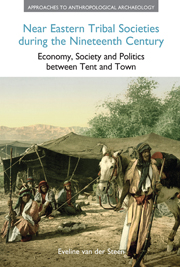 Near Eastern Tribal Societies during the Nineteenth Century
Near Eastern Tribal Societies during the Nineteenth Century Book contents
- Frontmatter
- Dedication
- Contents
- Acknowledgements
- Introduction
- 1 What is a tribe?
- 2 Travellers in the Levant during the nineteenth century
- 3 The dynamics of territorial and power structures
- 4 Oral traditions
- 5 Tribal society and its relation to the landscape
- 6 Tribal institutions
- 7 Relations between the tribes and the state
- 8 From tribe to tribal state: three case studies
- 9 The economy of tribal societies
- 10 Ethnicity and the sense of belonging
- 11 Women in tribal societies
- 12 Religion and folklore
- 13 Back in time: historical parallels
- Notes
- References
- Index
Introduction
- Frontmatter
- Dedication
- Contents
- Acknowledgements
- Introduction
- 1 What is a tribe?
- 2 Travellers in the Levant during the nineteenth century
- 3 The dynamics of territorial and power structures
- 4 Oral traditions
- 5 Tribal society and its relation to the landscape
- 6 Tribal institutions
- 7 Relations between the tribes and the state
- 8 From tribe to tribal state: three case studies
- 9 The economy of tribal societies
- 10 Ethnicity and the sense of belonging
- 11 Women in tribal societies
- 12 Religion and folklore
- 13 Back in time: historical parallels
- Notes
- References
- Index
Summary
For as long as we know, Near Eastern society has been fundamentally tribal. Its social structure, political institutions and economy have always been embedded in tribal frameworks. That tribal structure is not immutable, timeless or insulated from political, social and technological developments. The Near East has come a long way since the Early Bronze Age; people and societies have changed, in many cases dramatically. Nevertheless, archaeological and textual sources suggest that basic concepts of tribalism have been remarkably constant over time, and a prime mover in the history of the Near East.
Today structures of tribal organization are marginalized within small tribes on the edges of society, or transformed and incorporated within local and national governments. As a result, it is hard to imagine what a fully tribal society looked like before the age of globalization. Anthropological studies of present-day tribal societies are of little help.
There is, however, a vast pool of information, drawn from a time when the great tribes controlled the region: the observations and reports from travellers in the Near East in the nineteenth century, up to World War I (the Great War).
Napoleon's conquest of Egypt, his exploits into Palestine and the subsequent involvement of Britain shook the Ottoman Empire. The empire was already weakened by its wars with Russia and Austria, and by internal revolt. Now the French army crushed the Ottomans and they had to be rescued by the British. At the same time, the Ottoman economy was overtaken by the Industrial Revolution transforming Western Europe. Something had to give. Over the course of the nineteenth century, economic and political reform, influenced by Western ideas, although resisted by many, transformed the Near East.
- Type
- Chapter
- Information
- Near Eastern Tribal Societies during the Nineteenth CenturyEconomy, Society and Politics between Tent and Town, pp. xi - xviiiPublisher: Acumen PublishingPrint publication year: 2013


